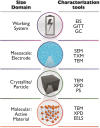Investigating the Complex Chemistry of Functional Energy Storage Systems: The Need for an Integrative, Multiscale (Molecular to Mesoscale) Perspective
- PMID: 27413781
- PMCID: PMC4919774
- DOI: 10.1021/acscentsci.6b00100
Investigating the Complex Chemistry of Functional Energy Storage Systems: The Need for an Integrative, Multiscale (Molecular to Mesoscale) Perspective
Abstract
Electric energy storage systems such as batteries can significantly impact society in a variety of ways, including facilitating the widespread deployment of portable electronic devices, enabling the use of renewable energy generation for local off grid situations and providing the basis of highly efficient power grids integrated with energy production, large stationary batteries, and the excess capacity from electric vehicles. A critical challenge for electric energy storage is understanding the basic science associated with the gap between the usable output of energy storage systems and their theoretical energy contents. The goal of overcoming this inefficiency is to achieve more useful work (w) and minimize the generation of waste heat (q). Minimization of inefficiency can be approached at the macro level, where bulk parameters are identified and manipulated, with optimization as an ultimate goal. However, such a strategy may not provide insight toward the complexities of electric energy storage, especially the inherent heterogeneity of ion and electron flux contributing to the local resistances at numerous interfaces found at several scale lengths within a battery. Thus, the ability to predict and ultimately tune these complex systems to specific applications, both current and future, demands not just parametrization at the bulk scale but rather specific experimentation and understanding over multiple length scales within the same battery system, from the molecular scale to the mesoscale. Herein, we provide a case study examining the insights and implications from multiscale investigations of a prospective battery material, Fe3O4.
Conflict of interest statement
The authors declare no competing financial interest.
Figures






References
-
- Bock D. C.; Kirshenbaum K. C.; Wang J.; Zhang W.; Wang F.; Wang J.; Marschilok A. C.; Takeuchi K. J.; Takeuchi E. S. 2D Cross Sectional Analysis and Associated Electrochemistry of Composite Electrodes Containing Dispersed Agglomerates of Nanocrystalline Magnetite, Fe3O4. ACS Appl. Mater. Interfaces 2015, 7, 13457–13466. 10.1021/acsami.5b02478. - DOI - PubMed
-
- Hemminger J.; Crabtree G.; Sarrao J.. From Quanta to the Continuum: Opportunities for Mesoscale Science: A Report from the Basic Energy Sciences Advisory Committee; Department of Energy Office of Basic Energy Sciences “Basic Research Needs” Report Series; 2012; pp 1–75.
-
- Rubloff G. W.; Lee S. B. New science at the meso frontier: Dense nanostructure architectures for electrical energy storage. Curr. Opin. Solid State Mater. Sci. 2015, 19, 227–234. 10.1016/j.cossms.2014.12.004. - DOI
-
- Amatucci G. G.; Pereira N. Fluoride based electrode materials for advanced energy storage devices. J. Fluorine Chem. 2007, 128, 243–262. 10.1016/j.jfluchem.2006.11.016. - DOI
Publication types
LinkOut - more resources
Full Text Sources
Other Literature Sources
Miscellaneous

